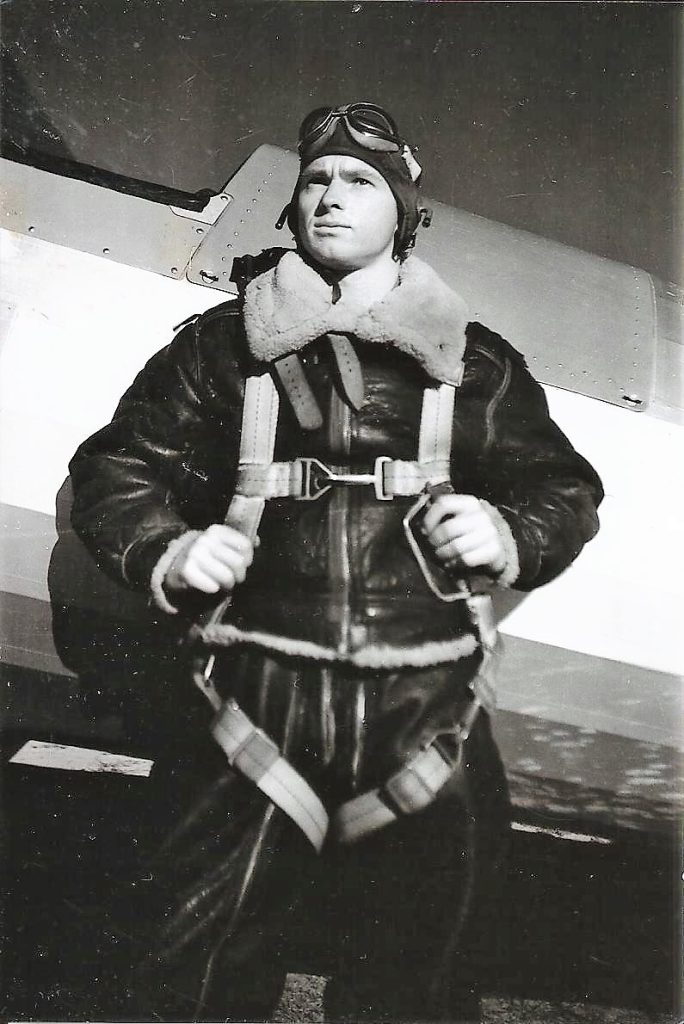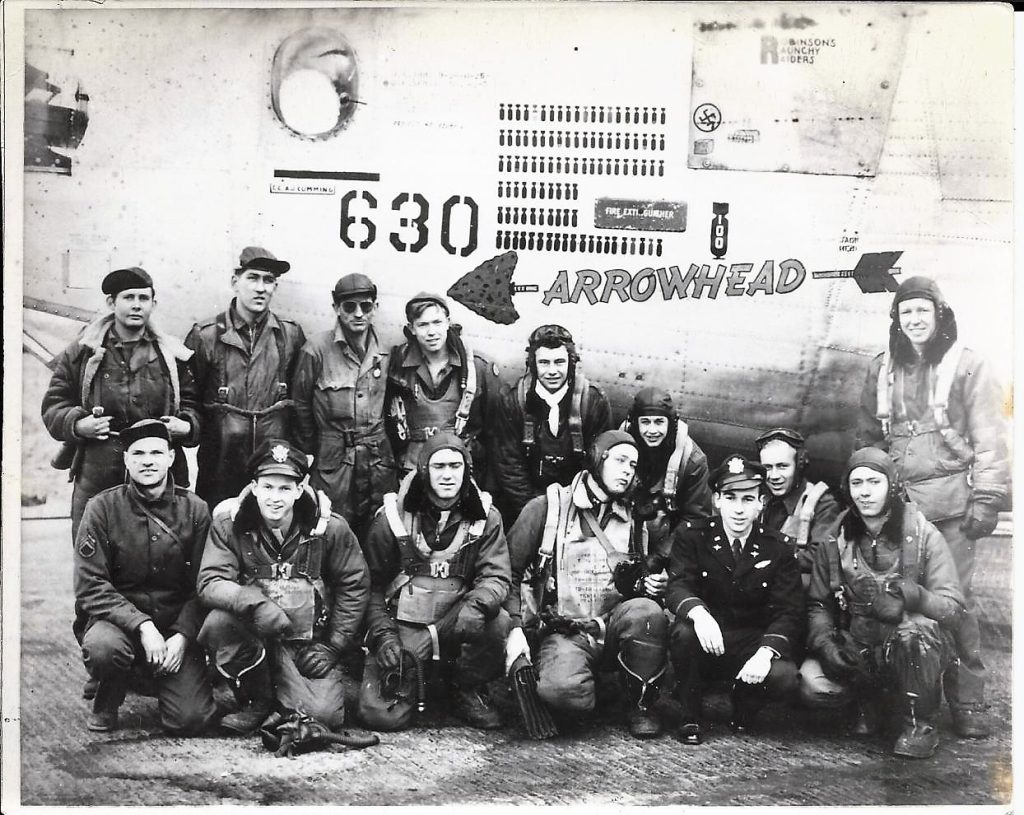By Debbie Adams
Capt. Russell Robinson of Mount Pleasant passed away on October 19 at the age of 97. Born in Salem, he graduated from Andrew Lewis High School in 1941 on a Friday. The following Monday he went to work for the railroad, while taking night classes in electrical work, welding, mechanics, sheet metal, meteorology, the theory of flight, and ground aviation school.
He moved to Baltimore and began working as an aircraft mechanic. Robinson wanted to enlist in the aviation cadet program, but he did not qualify because he had three dental cavities. He found a dentist; the next day he was accepted into the cadet program and began his training as an air cadet.
Before the war, aviation cadets were required to be 21 years old with a college degree. In 1941 the age was dropped to 18 with a high school diploma. Cadet flight training hours were reduced to meet the demand for military pilots. It took Robinson 13 months from enlistment to graduation.
Robinson did his primary training in Tennessee where the Army determined whether he had the aptitude to train as a navigator, a bombardier, or a pilot. Chosen to be a pilot, he completed his primary training on the PT-17, and then his basic training on BT-13s, learning to fly in formation, to fly by instruments or aerial navigation, to fly at night, and to fly for long distances. That was followed by advanced training on twin-engine AT-10s.

Upon graduation, Robinson was commissioned as a second lieutenant, an honor given to those at the top of the class. Training was arduous and often up to a third of an entering class would not graduate.
Although Robinson had wanted to fly fighter planes, the Army decided he was better suited to be a bomber pilot – B-24 heavy bombers, specifically. He was assigned to Connecticut to be assimilated into a crew of men from across the country. At age 21, Robinson found himself in charge of a crew of 10. He was the oldest; the youngest was 17. He was dubbed “Lucky Worrybird” by his men because he was so concerned with taking care of them.
Their final stop stateside was Charleston, S.C., where the crew trained together to become one fighting unit. Each crew had four officers: the pilot, co-pilot, navigator, and bombardier, and six enlisted men. His crew was sent overseas in November 1944, stationed at Old Buckenham airbase in England,
Robinson flew 34 missions out of “Old Buck,” all to Germany. Aircraft would take off and form a group of 33 planes, in squadrons of 11 and fly the two or three hours over France to get to various targets in Germany. Their targets were factories, highway intersections, railroads, fuel plants, bridges, and tank factories. On each mission, they would be gone from England for five to eight hours.
Robinson and his crew flew a B-24 “Liberator” bomber with four engines and a twin tail in the Mighty Eighth Air Force, United States Army Air Forces, 732nd Squadron, 453rd Bomb Group.
Crew Chief Andy Cumming named their plane “Arrowhead” after a spot in California which had an arrowhead carved on the mountainside. During Robinson’s time as its pilot, Arrowhead received the honor of being the first plane to complete over 100 missions without an abort.
Flying a B-24 was no easy task. Flying at altitudes of over 20,000 feet, temperatures were sometimes down to 50 degrees below zero. Winds whipped through the cabin. The crew wore electric suits to keep warm. The gunners had to wear gloves, because if their bare skin touched metal, it would stick. Once, Robinson’s electric suit stopped working and his hands were frozen to the wheel. He didn’t realize that he was lapsing into hypothermia until one of his men began beating on him to help keep the blood flowing and warm him up.
On one mission, mortar fire from the German 88mm guns on the ground went through Arrowhead’s bomb bay and lodged pieces of flak in the wall between the glass tubes of fuel and the cables that controlled the elevators and rudders.
“Getting airborne was sometimes more dangerous than flying over Germany,” said Robinson. “Some missions were so large that planes would take off from bases six to eight miles apart at the rate of one each minute for over an hour. Sometimes 1200 planes would be involved in a bombing raid.”
The 34 combat missions Robinson is credited with do not include all the missions he flew. They didn’t always drop bombs; sometimes they dropped supplies.

Robinson and his crew provided air support during the Battle of the Bulge on Christmas Day in 1944. The Battle began on December 16, but for days there was too much cloud cover and snow to provide air support to General Patton and his troops. Finally, on December 24, the clouds cleared, and they could see Patton advancing, tanks firing in every direction – “no ammunition spared.”
Thanks to Patton, his troops, and Allied air support, the Germans were stopped a quarter mile from a large Allied fuel storage area, where they would have been able to refuel and continue the fight.
After the war, Robinson attended Roanoke College. According to his family, he “embraced a career as an architect for 30 years and was involved for many years with the North Carolina National Guard.” He established Arrowhead Drafting Services.
Through the years, Robinson shared his war stories with students in the area from elementary to high school, with civic organizations, and at the D-Day Memorial, especially in commemoration of Veterans Day.
“Russell was an American hero and Patriot in the truest sense,” said Jeff Bush of the Roanoke 8th Air Force WWII Historical Society, who facilitated many events honoring Robinson and other veterans. “Russell was special, and his legacy will live on. I was so honored for Russell to take his time and share his WWII stories with me. It was such an honor and joy building our friendship over many years and getting to know his many hobbies, friends, and family. One of our special memories was going over to Russell’s house around Christmas sharing dinner and gifts with him.”
In 2013, Robinson, legendary pilot Bill Overstreet, and two other U.S. Army Air Corps veterans from World War II were invited by retired Navy Commander Dr. Clare Weidman to his airstrip in Botetourt County to fly in his restored PT-17 Stearman. Each had a turn taking the controls of the two-seater training aircraft in which he had started his flying career.
After Robinson, age 89, returned to the hangar, Weidman’s comment was, “He can sure fly an airplane, and that’s not an easy plane to fly.”











